10th MAY 2015 SURYA DEV - SIGNIFICANCE - DEVOTION

The Significance of Surya in Vedas
Surya is the Sun God. He is also known as the mitra or the friend. He has been given huge importance in the Vedas. Surya is the head of all the planets. He has immense powers. The life on earth is controlled by the Surya.
If Surya is unhappy it can be very dangerous for the world. He controls the seven seasons that we see every year. Surya is represented sitting in a chariot that is pulled by seven horses. Sometimes the seven horses are removed and one horse is depicted with seven heads. These seven horses depict the seven seasons and the seven colours of the rainbow. We in this article will discuss the significance of Surya in Vedas.
Vedas are the ancient scriptures of India. They contain all the knowledge that is required by anyone. Surya is the head of the navagrahas or the 9 planets. He is the supreme planet. This is exactly why Surya is worshiped in many parts of the country. There are temples that are dedicated to Surya. Some of them are centuries old.
There is a dynasty called Suryavansh. It is said that this dynasty was started by Surya Dev. Lord Rama was born in this family. Sunday is the day of Surya. The three most popular temples of Surya are the Konarak in Orissa, Lolarka in Uttar Pradesh and Balarka in Rajasthan. The grandest of all the three is the Konarak. The Surya has three wives. They were Saranyu, Ragyi and Prabha. In some temples the statue Surya dev can be found with that of his wives. He had two sons Shani and Yama. They both give judgement for the people on earth. Yama is the lord of death. Yama also had a sister named Yami.
Surya was the father of Sugriva who helped Lord Rama to kill Ravana. Karna the son of Kunti in Mahabharata was also the son of Surya. Surya was always worshiped by the people. There is a section dedicated in the Vedas about how Surya Dev must be worshipped. The Surya namaskar is a very powerful mantra that is recited to please the Surya dev. This mantra is recited by the people early in the morning. The wordings of this mantra were mentioned in the Vedas. It is said that by reciting this mantra our souls can be purified. It can protect us from all the trouble and perils in life. Surya dev was worshipped by man, gods and well as the asuras.
In the Vedas it is mentioned that Surya is the eye of mitra, varuna and Agni. This is why he is given a lot of importance in the scriptures and in the Vedas. Surya is associated with fame, will power, success, authority and kingship. Because of these qualities Surya is considered a very important planet in the Vedic astrology. It is said that those who have a strong Surya will be highly successful in life.









-9882.jpg)

The ones who have a weak Surya generally cannot succeed much in life. The Surya if placed in the tenth house it is considered to be the strongest. Surya is the lord of three Nakshatras namely Krittika, Uttar Phalguni and Uttara Ashadha. The Surya dev is associated with colours like red and copper. This is exactly why the gem stone ruby is advised to those who have a weak sun. This stone must be worn in gold for the best results.
There is a complete chapter in the Vedic astrology that is dedicated to the Surya. It is one of the most prominent planets and must be given the due importance by the astrologers. The sun line in the palm is the indicator of the Surya. If we have a weak sun line we will not be much successful in life. This is clearly mentioned in the Vedas. The successful people will mostly have a strong sun.
Surya is mentioned among one of the Adityas in the Mahabharata. There are many festivals in India that are dedicated to the Surya. The Makar Sankranti is dedicated to the Surya dev this is the festival that celebrates a good harvest. Chhath is another popular festival in India.
This too is dedicated to the Surya dev. These are some of the most important festivals. They are basically celebrated to please the Surya dev. They are used to thank the lord for his love and blessings. The Surya dev. is also thanked for the blessings that he has showered on us.
The surya dev is also mentioned in the yoga. Yoga is another knowledge that the vedas contain. The vedas clearly mention how beneficial it is to do yoga when the sun is just rising. There are twelve yogic postures that are associated with the surya namaskar mantra.
This yoga is called the surya namaskar. This yoga must be done while uttering the mantras of surya namaskar. It can protect us from many diseases. If done well this can also help in weight loss.
The Significance of Surya in Vedas is immense. We have tried to cover some of these aspects in this article. We hope this will give you a better idea about Surya.
Suggested Reading: You Might Like These Also
Yahoo MediaNet Ads
Surya
From Wikipedia, the free encyclopedia
For other uses, see Surya (disambiguation).
"Bhanu" redirects here. For the village development committee in Nepal, see Bhanu, Nepal. For Indian actress, see Muktha (actress).
| Surya | |
|---|---|
| Sun God | |

A 19th-century painting of Surya on his chariot
| |
| Devanagari | सूर्य |
| SanskritTransliteration | sūrya |
| Affiliation | Graha, Deva |
| Abode | Surya loka |
| Mantra | Om Suryaya namaha, Om Karyaaya namaha, Om Arkaya namaha |
| Consort | Saranyu, Ragyi, Prabha,Ushas, and Chhaya |
| Mount | Chariot drawn by seven white horses Charioteer : Aruna[1] |
Surya (/ˈsʊərjə/; Sanskrit: सूर्य Sūrya, "the Supreme Light"[2]), also known as Aditya, Bhanu or Ravi, is the chief solar deity in Hinduism and generally refers to the Sun.[3][4]
Surya is the chief of the Navagraha, the nine Indian Classical planets and important elements of Hindu astrology. He is often depicted riding a chariot harnessed by seven horses[1] which might represent the seven colors of the rainbow or the seven chakras in the body. He is also the presiding deity of Sunday. Surya is regarded as the Supreme Deity by Saura sect and Smartas worship him as one of the five primary forms of God. The sun god, Zun, worshipped by the Afghan Zunbil dynasty, is thought to be synonymous with Surya.
Contents
[hide]Depictions[edit]
Arka form[edit]
"Arka" form is worshiped mostly in North India and Eastern parts of India. The temples dedicated to the 'Arka' form of Surya are Konark Temple in Orissa, Uttararka and Lolarka in Uttar Pradesh, and Balarka in Rajasthan. There was an old sun temple in Bahraich, Uttar Pradesh named Balarka Surya Mandir, built by King Tilokchand Arkawanshi in early 10th century AD which was destroyed in the 14th century during the Turkish invasions. The Surya temple in Konark was built by Ganga Vamsi king Narasimha Dev. Sun Temple, Modhera in Gujarat was built in 1026 AD by King Bhimdev of Solanki dynasty.
Mitra form[edit]
Surya is also known as "Mitra" (meaning friend) for his life nourishing properties. The Mitra form of 'Surya' had been worshiped mostly in Gujarat, where a clan of Suryawanshi kings was known as Mitrawanshi kshatriyas, also known by its derivative name "Maitrakas".
Religious role and relations[edit]
See also: Ratha Saptami
Surya had three wives: Saranyu, Ragyi and Prabha. Saranyu was the mother of Vaivasvata Manu (the seventh, i.e., present Manu) and the twins Yama (the Lord of Death) and his sister Yami. She also bore him the twins known as the Ashvins, divine horsemen and physicians to the Devas. Saranyu, being unable to bear the extreme radiance of Surya, created a superficial entity from her shadow called Chhaya and instructed her to act as Surya's wife in her absence. Chhaya mothered two sons Savarni Manu (the eighth, i.e., next Manu) and Shani (the planet Saturn), and two daughters, Tapti and Vishti.[5] He has two more sons, Revanta with Ragyi, andPrabhata with Prabha. Surya is the father of the famous tragic hero Karna, described in the Indian epic Mahabharata, by a human princess named Kunti.
Surya's sons, Shani and Yama, are responsible for the judgment of human life. Shani provides the results of one's deeds during one's life through appropriate punishments and rewards while Yama grants the results of one's deeds after death.[6]
Like some other deities, such as Shiva (who are worshiped by saints, normal worshipers and demons), Surya has a following of the same types of beings. A group of Raksasas known as Yatudhanas were the followers of Surya and wandered with him.[7] It is mentioned that Bhauvana the Daitya offered a prayer to Surya with the Rathantara saman and was immediately turned into an elephant.[7]
His Greek counterpart is Helios and his Egyptian counterpart is Ra. There is said to be a community among Aryans called Okkot who worship Surya.
Representation in scriptures[edit]
In the Ramayana, Surya is described as father of the King Sugriva, who helped Rama and Lakshmana in defeating the demon king Ravana. He also trains Hanuman. The Suryavanshi dynasty of kings, Rama being one of them, also claims descent from Surya.
In the Mahabharata, Princess Kunti receives instruction for a mantra from the sage Durvasa; by reciting which, she would be able to summon any god and bear a child by him. Incredulous of the power of this mantra, Kunti unwittingly tests it on Surya, but when Surya appears, she gets scared and requests him to go back. However, Surya has an obligation to fulfill the mantra before returning. Surya miraculously causes Kunti to bear the child immediately whilst retaining her virginity so that she, as an unmarried princess, need not face any embarrassment or be subjected to questions from society. Kunti feels compelled to abandon the child, Karna, who grows up to become one of the central characters in the great battle of Kurukshetra.
In the Vedas, Surya is frequently referred to as "the eye of Mitra, Varuna, and Agni" (RV 1.115.1, RV 6.51.1, RV 7.63.1, WYV 4.35, WYV 7.42, WYV 13.46, AV 13.2.35). Lord Surya is also considered to be the eye of the Virat Purusha (Lord Sri Krishna's Universal Form).
In astrology[edit]
In Vedic astrology Surya is considered a mild malefic on account of his hot, dry nature. Surya represents soul, will-power, fame, the eyes, general vitality, courage, kingship, father, highly placed persons and authority. He is exalted in the sign Mesha, is in mulatrikona in the sign Simha and is in debilitation in the sign Tula. Surya is lord of three nakshatras or lunar mansions: Krittika, Uttara Phalguni and Uttara Ashadha. Surya has the following associations: the colors – copper or red, the metals – gold or brass, the gemstone – ruby, the direction – east and the season of summer. The food grain associated with him is wheat.
Sun Temples[edit]
See also: Konark Sun Temple, Buguda Biranchinarayan Temple, Martand Sun Temple, Multan Sun Temple and Sun Temple, Modhera
There are Surya temples all across India. The most famous is the World Heritage Site of the Sun Temple, Konark, Orissa. Besides Konark, there are two other sun temples in Orissa called Biranchi Narayan Sun Temple[8] inBuguda, Ganjam District and Biranchinarayan Temple, Palia, Bhadrak.
There are sun temples in Modhera, Gujarat, created by King Bhimdev of the Solanki dynasty, in Arasavalli, Andhra Pradesh, Kanakaditya Temple in Kasheli (Dist. Sindhudurg) – Maharashtra, near the famous Galtaji's temple in Jaipur, Rajasthan and in clusters of Navagraha temples in Tamil Nadu and Assam. The Sun Temple at Martand in Jammu and Kashmir and Sun Temple of Multan are temples which were destroyed. The only and the famous Surya temple in northern India is Kattarmal surya mandir in Almora District, Uttarakhand created by King Kattarmal in the 12th century.
The Gurjars were essentially sun worshipers and some of the sun temples were erected by them during the medieval period.[9] The sun temple known as Jayaditya was constructed by Gurjar king of Nandipuri, Jayabhatta II. This temple is situated at Kotipura near Kapika in the Bharukachha district.[10] The Surya temple of Bhinmal known as Jagaswami Surya temple was also erected during this period.[11]
Festivals[edit]
There are festivals dedicated to Sun God Surya in India.
Pongal or Makara Sankaranti is the most widely celebrated Hindu festival dedicated to the Sun God. It is celebrated as Makara Sankranti in many parts of India and as Pongal by Tamils all over the world. People thank the Sun God for ensuring a good harvest and dedicate the first grain to him.
Chhath is another Hindu festival dedicated to Surya. It is believed to started by Karna, the son of Surya, who became a great warrior and fought against the Pandavas in the Kurukshetra War. Chhath is unique to Bihar,Jharkhand, and some parts of Uttar Pradesh and Nepal.
Samba Dashami is celebrated in the eastern coastal state of Orissa in the honour of Samba, the son of Krishna who was cured of leprosy by praying to Surya.
Ratha Saptami is a Hindu festival that falls on the seventh day (Saptami) of the bright half of the Hindu month Maagha.[12] This day is also known as Surya Jayanti because it celebrates the power of the Sun God.
Women in Goa observe Aytar Puja (Aytar is a Konkani word for Sunday, from Sanskrit Adityavasara) on Sundays of the Hindu lunar month of Shravana.[13] Known as Aditya Vrata in Sanskrit, this observance is known as Aditya Ranubai in Maharashtra.[14] Aditya and his consort Rajni are invoked on these days.
Surya Namaskar[edit]
A well-known Hindu mode of worship of the devotional movements of Surya is done at the rising of the Sun, known as Sūrya namaskāra (sun salutation). Ten yogic postures are assumed in successive flowing movements to complete one namaskar. Twelve sacred Hindu mantras uttered and for each mantra one complete namaskar is done. Ancient practice is to do 108 namaskaras a day. It is considered most auspicious by Hindus to do this.
The 13 mantras for surya namaskara:
- ॐ मित्राय नमः Om mitrāya namah
- ॐ रवये नमः Om ravayé namah
- ॐ सूर्याय नमः Om sūryāya namah
- ॐ भानवे नमः Om bhānavé namah
- ॐ खगाय नमः Om khagāya namah
- ॐ पूष्णे नमः Om pūṣṇé namah
- ॐ हिरण्यगर्भाय नमः Om hiraṇyagarbhāya namah
- ॐ मरीचये नमः Om marīchayé namah
- ॐ आदित्याय नमः Om ādityāya namah
- ॐ सवित्रे नमः Om savitré namah
- ॐ अर्काय नमः Om arkāya namah
- ॐ भास्कराय नमः Om bhāskarāya namah
- ॐ श्री सबित्रू सुर्यनारायणाय नमः om shree sabitru suryanarayanaya namah
The Gayatri Mantra is associated with Surya.[16] Another hymn associated with Surya is the Aditya Hridayam, recited by the great sage Agastya to Rama on the warfield before the fight with Ravana.
See also[edit]
References[edit]
- ^ a b Jansen, Eva Rudy. The Book of Hindu Imagery: Gods, Manifestations and Their Meaning, p. 65.
- ^ Wilhelm, Ernst. Graha Sutras, Kala Occult Publishers, p.49. ISBN 0-9709636-4-5
- ^ Alexandra Anna Enrica van der Geer (2008). Animals in Stone: Indian Mammals Sculptured Through Time. BRILL. pp. 236–. ISBN 90-04-16819-2.
- ^ Gopal, Madan (1990). K.S. Gautam, ed. India through the ages. Publication Division, Ministry of Information and Broadcasting, Government of India. p. 76.
- ^ Padma Purana – Chap Srishtikhand, section 8
- ^ Shanicharananuragi 'datti' Madan Maharaj Rajasthani. Effectuation of Shani Adoration. Saturn Publications Pvt. Ltd. pp. 10–. ISBN 978-81-906327-1-3. Retrieved 13 October 2012.
- ^ a b P. 67 Cultural History From The Vayu Purana by Devendrakumar Rajaram Patil, Rajaram D. K. Patil
- ^ (Biranchi Narayan Temple – http://www.viranchinarayan.org)
- ^ Lālatā Prasāda Pāṇḍeya (1971). Sun-worship in ancient India. Motilal Banarsidass. p. 245
- ^ Oriental Institute (Vadodara, India) (2000). Gujarat under the Maitrakas of Valabhī: history and culture of Gujarat during the Maitraka period, circa 470–788 A.D. Oriental Institute. p. 133. Retrieved 14 July 2011.
- ^ Asha Kalia (1982). Art of Osian temples: socio-economic and religious life in India, 8th–12th centuries A.D. Abhinav Publications. pp. 2–. ISBN 978-0-391-02558-5. Retrieved 14 July 2011.
- ^ Swami Sivananda, Ratha Saptami
- ^ "Seeking the sun's blessings". http://timesofindia.indiatimes.com. Times of India. Retrieved 14 August 2014.
- ^ Feldhaus, Anne (1996). Images of Women in Maharashtrian Literature and Religion. SUNY Pres. pp. 168–167. ISBN 0-7914-2838-9.
- ^ Indian Express (04-09-2010). Destination Delhi.
- ^ "SURYA AYURVEDA: THE HEALING SCIENCE OF THE SUN".
External links[edit]
| Wikimedia Commons has media related to Surya. |
- An ancient hymn to Surya – from the Rig Veda
- Weekly podcast on Vedic Chanting and Vedic Mythology with stories from the Puranas
- Surya Upanishad (Wikisource)
| |||
| ||
| |||
| |||
























0 Comments:
Post a Comment
Subscribe to Post Comments [Atom]
<< Home